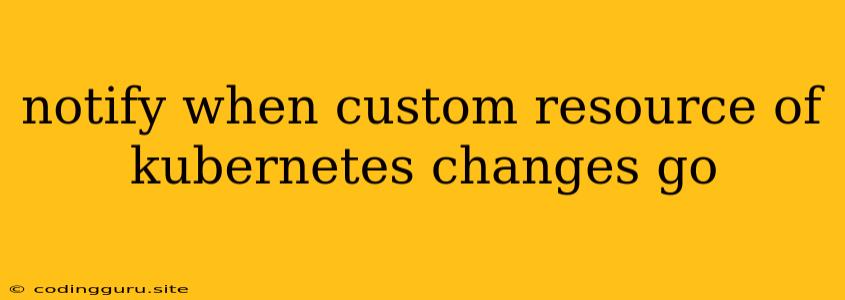How to Be Notified When a Custom Resource in Kubernetes Changes Using Go
In the world of Kubernetes, custom resources (CRDs) are a powerful tool for extending the platform and managing your applications. But how do you stay informed when these custom resources change? This article will guide you through building a Go-based solution to receive real-time notifications when your custom resources are updated.
Understanding the Need for Real-time Updates
Imagine you have a custom resource representing a complex service deployed on your Kubernetes cluster. It could be anything from a database with specific configuration options to a custom API gateway. You want to be alerted whenever this resource undergoes modifications, whether it's a change in its configuration, scaling, or even deletion. This is where the need for real-time notifications comes in.
The Power of Kubernetes Watchers
Kubernetes provides a powerful mechanism called "Watchers" that enables you to monitor changes within your cluster. Watchers allow you to observe specific resources, be it pods, deployments, or even your custom resources.
Setting Up the Watch
Let's dive into the core of the solution using a Go code snippet. This example will demonstrate how to set up a watcher for your custom resource and process incoming changes.
package main
import (
"context"
metav1 "k8s.io/apimachinery/pkg/apis/meta/v1"
"k8s.io/apimachinery/pkg/runtime"
"k8s.io/apimachinery/pkg/watch"
"k8s.io/client-go/kubernetes"
"k8s.io/client-go/rest"
"k8s.io/client-go/tools/clientcmd"
)
// Define your custom resource type (replace with your actual type)
type MyCustomResource struct {
metav1.TypeMeta `json:",inline"`
metav1.ObjectMeta `json:"metadata,omitempty"`
// Your custom resource fields here
Spec MyCustomResourceSpec `json:"spec"`
Status MyCustomResourceStatus `json:"status"`
}
// Define the spec and status structures (replace with your actual definitions)
type MyCustomResourceSpec struct {
// Your custom resource spec fields
}
type MyCustomResourceStatus struct {
// Your custom resource status fields
}
func main() {
// Configure the Kubernetes client
config, err := rest.InClusterConfig()
if err != nil {
config, err = clientcmd.BuildConfigFromFlags("", clientcmd.RecommendedHomeFile)
if err != nil {
panic(err)
}
}
clientset, err := kubernetes.NewForConfig(config)
if err != nil {
panic(err)
}
// Create a watcher for your custom resource
watcher, err := clientset.CustomResources("your-group", "your-version").
Namespace("your-namespace").
Watch(context.Background(), metav1.ListOptions{})
if err != nil {
panic(err)
}
// Process changes from the watcher
for event := range watcher.ResultChan() {
switch event.Type {
case watch.Added:
// Handle creation of a custom resource
newResource := event.Object.(*MyCustomResource)
// Process the new resource (e.g., log, send notifications)
// ...
case watch.Modified:
// Handle modification of a custom resource
modifiedResource := event.Object.(*MyCustomResource)
// Process the modified resource (e.g., update state, send notifications)
// ...
case watch.Deleted:
// Handle deletion of a custom resource
deletedResource := event.Object.(*MyCustomResource)
// Process the deleted resource (e.g., log, clean up resources)
// ...
}
}
}
Explanation of the code:
- Import necessary packages: This imports the required Kubernetes client-go packages and your custom resource definitions.
- Configure the Kubernetes client: This section sets up a connection to your Kubernetes cluster using either in-cluster configuration (for running within a Kubernetes pod) or kubeconfig file.
- Create a watcher: You initialize a watcher specifically for your custom resource type.
- Process incoming changes: The code enters a loop, waiting for events from the watcher.
- Handle events: You process each event individually:
- Added: This signals the creation of a new custom resource.
- Modified: Indicates a change in an existing resource.
- Deleted: Indicates that a resource has been removed.
Implementing Notifications
Now that you're receiving real-time updates from your custom resources, you can implement various notification methods. Here are some common options:
- Log messages: Log changes directly to your application logs. This is a simple way to track events.
- Email notifications: Send email alerts to specific recipients whenever changes occur. This is useful for keeping relevant teams informed.
- Messaging systems: Leverage platforms like Slack, Teams, or other messaging tools to send alerts. This provides a more interactive and real-time notification system.
- Triggering actions: Integrate with other systems like continuous integration (CI) pipelines to trigger actions based on custom resource updates.
Best Practices for Building Robust Solutions
- Robust error handling: Handle potential errors during watcher setup or event processing gracefully.
- Throttling: Prevent excessive notifications by implementing rate limiting or batching updates.
- Testing: Thoroughly test your solution to ensure it correctly handles various custom resource changes.
- Security: Securely implement authentication and authorization to prevent unauthorized access to your watcher.
Conclusion
By leveraging Kubernetes watchers and Go, you can gain valuable insights into the real-time state of your custom resources. This empowers you to build sophisticated solutions, automate workflows, and maintain close control over your Kubernetes deployments. Remember to always implement your notification mechanisms securely and with a robust error handling strategy to ensure your solution remains reliable and effective.
